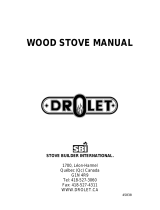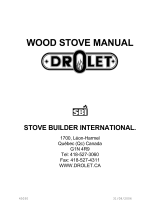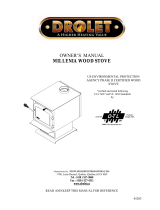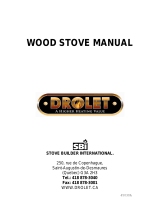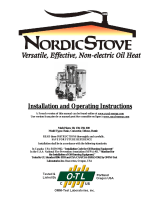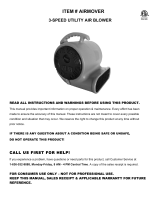Page is loading ...

OWNER`S MANUAL
OIL BURNING STOVE
YUKON
Verified and tested following
CAN/CSA B140.3 et UL 896 standards by:
Intertek Testing Services
Manufactured by:
1700 Léon-Harmel
Québec, (Québec)
G1N 4R9
www.drolet.ca
Tel. : (418) 527-3060
Fax : (418) 527-4311
READ THESE INSTRUCTIONS AND SAVE FOR FUTURE REFERENCE
45045a _fev 03

TABLE OF CONTENT
TECHNICAL DATA.............................................................................................................................2
INSTALLATION INSTRUCTIONS.........................................................................................................3
POSITIONING THE STOVE ...................................................................................................................3
CHIMNEY INFORMATIONS .................................................................................................................4
CONNECTING THE STOVE TO THE CHIMNEY................................................................................5
LEVELLING THE STOVE ......................................................................................................................6
FIXING THE STOVE TO THE FLOOR..................................................................................................6
CONNECTING THE STOVE TO THE OIL TANK...............................................................................7
MEASURING AND ADJUSTING THE DRAFT....................................................................................8
OPERATING INSTRUCTIONS................................................................................................................9
COMBUSTIBLE.......................................................................................................................................9
LIGHTING................................................................................................................................................9
CHANGING THE INTENSITY .............................................................................................................10
TURNING THE STOVE OFF ................................................................................................................11
MAINTENANCE....................................................................................................................................11
FREQUENTLY ASKED QUESTIONS ..................................................................................................12
TROUBLE SHOOTING...........................................................................................................................20
LIMITED WARRANTY...........................................................................................................................30
Page 1 of 30

TECHNICAL DATA
YUKON OIL BURNING APPLIANCE
COMBUSTIBLE : OIL N
O
1 OIL N
O
2
HEAT INPUT : kW BTU/h kW BTU/h
Minimum : 4,8 16 600 3,7 12 800
Maximum : 10,7 36 800 10,3 35 550
FLOWRATE : cc/min litres/h cc/min litres/h
Minimum : 7,8 0,47 5,8 0,35
maximum : 17,3 1,04 16,1 0,97
MINIMUM DRAFT REQUIRED : 0,05 INWC 0,05 INWC
EFFICIENCY : % %
with fan : 77 74,5
without fan : 73 72
CLEARANCES TO COMBUSTIBLES
mm in
Back 180 7
Side 150 6
Corners 150 6
Top 915 36
A MINIMUM CLEARANCE OF 9’’ (230 mm)
FROM PIPE TO COMBUSTIBLES SHOULD BE
ALLOWED.
DIMENSIONS
mm in
Height : 745 29 ¼
Width : 620 24 ½
Depth : 675 26 ½
Flue pipe diameter: 130 5
Burner diameter : 200 8
Glass ( 3 ) : 144 x 264 5
11/16
x 10
13/32
Weight : 84 kg 185 lbs
Page 2 of 30

INSTALLATION INSTRUCTIONS
POSITIONING THE STOVE
• Position the stove as close as possible to the chimney.
• Many configurations are possible, the most frequent are illustrated in figures 1, 2 and 3.
• Respect the clearances indicated on page 1. They reflect Canadian and American safety standards.
• Always respect the clearances specified by the pipe manufacturers. Larger clearances always prevail.
Figure 1 : CORNER INSTALLATION
Figure 2 : PARALLEL INSTALLATION
Figure 3 : WALL INSTALLATION
Table 1 : CLEARANCES TO COMBUSTIBLES
mm in
Back 180 7
Side 150 6
Corners 150 6
Top 915 36
Flue Pipe 230 9
• IMPORTANT: It is essential to ensure that the room in which the stove is installed is sufficiently ventilated
to provide an adequate air supply.
THE BURNING OF ONE LITRE OF FUEL (OIL) REQUIRES APPROXIMATELY 30 M
3
OF AIR AND WILL
PRODUCE ABOUT 0.8 KG OF WATER VAPOR AND 9 M
3
OF CARBONE DIOXIDE AND ATMOSPHERIC
NITROGEN. A SOURCE OF AIR COMING FROM OUTSIDE THE HOUSE IS NECESSARY TO REPLACE
COMBUSTION AIR. THIS IS ESPECIALLY TRUE IF YOUR HOUSE IS NEW AND WELL INSULATED.
Page 3 of 30

CHIMNEY INFORMATIONS
• Before you hook up the stove, inspect the chimney to ensure that it is in good condition.
• Your stove is approved on factory built type A or type L chimney. The chimney has to be well insulated; a
chimney with a cold internal surface can prevent a good draft and create condensation.
• Chimney sections must be of equal diameter. A 5" factory built chimney is required. A larger diameter will
have a greater volume and will be more difficult to heat. This can lead to draft problems.
• Masonry chimneys are often oversized. You must insert a 5” stainless steel liner in your oversized
masonry chimney in order to reduce its internal diameter to 5 inches.
• The chimney should be at least 15' high (including stove pipe sections). The chimney has to extend at
least 3’ above the point where is comes out of the roof and at least 2' higher than the tallest roof point or
any structure within a horizontal distance of 10’.
• MINIMUM CHIMNEY HEIGHT :
The height of the chimney should be at least 15’
(4.6 m).
Figure 4: MINIMUM CHIMNEY HEIGHT
• CLEARANCES WITH THE ROOF TOP AND
STRUCTURES NEARBY:
The chimney shall extend at least 2’ (0,6 m)
above the highest roof point or any structure
within an horizontal distance of 10’ (3,05 m).
Figure 5: CHIMNEY CLEARANCES
• CLEARANCE FROM THE ROOF :
• The chimney shall extend at least 3’ (0,91 m) above the point where it comes out of the roof and at least 2'
higher than the tallest roof point or any structure within a horizontal distance of 10’. ref.: standard B-139 -
4.2.2.11.
YOUR STOVE SHALL BE CONNECTED TO A CHIMNEY WHICH WILL PROVIDE AN
ADEQUATE DRAFT AT ALL TIMES TO ENSURE SAFE AND PROPER OPERATION OF
THE BURNER
Page 4 of 30

CONNECTING THE STOVE TO THE CHIMNEY
• The combustion residues are vented at the back of the stove. The female part of the black pipe connector
has to be inserted in the flue outlet of the stove. Secure all connections with 3 metal screws, positioned at
a 120
o
distance from one another.
• The connection between the black pipe and the chimney has to be perfectly airtight.
• A maximum horizontal length of 8 feet is allowed. Make sure you have a minimum slope of 1/4" per foot.
• Do not use more than two 90
o
elbows in your connections.
• It is strictly forbidden to pass through combustible materials walls, floors, or ceilings with a black pipe
connector.
DIRECT HORIZONTAL CONNECTION :
You can connect your stove to the chimney
using only a horizontal black pipe connector.
Figure 6: DIRECT HORIZONTAL CONNECTION.
CEILING CONNECTION :
If your chimney starts at the ceiling level, use
one 90º elbow and the necessary black pipe
sections to reach the chimney.
Figure 7: CEILING CONNECTION.
• THE CHIMNEY MUST NOT BE SHARED WITH
OTHER APPLIANCES.
• FIX THE BLACK PIPE CONNECTORS
TOGETHER WITH METAL SCREWS.
• MAKE SURE YOU RESPECT A MINIMUM
SLOPE OF ¼’’ PER FOOT OF HORIZONTAL
PIPE LENGTH.
• RESPECT CLEARANCES TO COMBUSTIBLES
VERY CAREFULLY. THEY ARE PRESCRIBED
BY THE PIPE MANUFACTURER.
• PIPE CLEARANCES TO COMBUSTIBLES MAY
VARY DEPENDING ON THE TYPE AND THE
MANUFACTURER.
VERTICAL CONNECTION :
It is recommended not to use more than two (2)
90º elbows when connecting your stove to the
chimney. Otherwise, draft problems may occur.
Figure 8: VERTICAL CONNECTION.
Page 5 of 30

LEVELLING THE STOVE
• Now that the stove is into place and properly
hooked up to the chimney, you have to adjust the
level of the burner.
• Put the level on the burner’s rim, parallel to the
door. (Figure 9A). Screw or unscrew the
adjustable threaded legs to level the burner. Use
a 7/16" or 10 mm key.
• Put the level on the burner’s rim, parallel to the
sides. (Figure 9B). Screw or unscrew the
adjustable threaded legs to level the burner. Use
a 7/16" or 10 mm key
Figure 9A: LEVELLING THE BURNER
IMPORTANT :
IT IS VERY IMPORTANT THAT THE BURNER
ALWAYS BE LEVEL TO ALLOW A PROPER OIL
DISTRIBUTION INSIDE THE BURNER AND A
PROPER OIL VAPOR DISTRIBUTION THROUGH
THE CATALYTIC RINGS.
Figure 9B: LEVELLING THE BURNER
FIXING THE STOVE TO THE FLOOR
• The stove must be fixed in its location using the
two fixation brackets. Install the brackets on the
two adjustable back legs. (figure 11)
• If the floor is made of combustible material, it is
preferable to install the stove on a non
combustible surface that covers an area at least
equal to the size of the stove.
Figure 10: INSTALLATION OF FIXATION
BRACKETS
Page 6 of 30

CONNECTING THE STOVE TO THE OIL TANK
• Make sure that the oil tank is 12" (305 mm) higher than the carburetor. This is very important, since the
stove is gravity fed.
• Use only copper piping to connect the tank to the stove.
• Make sure that there is a continuous slope going from the tank to the stove.
• A 1/4" slope per foot is needed on the tank itself, from front to back. This will keep residue accumulations
at the back of the oil tank. Otherwise, residues could clog the oil line.
• When the tank is installed outside the house, it is always preferable to use oil #1 in order to avoid
viscosity problems.
NOTE : THE TANK SHALL BE LOCATED IN AN AREA WHERE IT WILL NOT BE EXPOSED TO THE
DIRECT RAYS OF THE SUN OR ADJACENT TO ANY SOURCE OF INTENSE HEAT.
Figure 11 : OIL TANK CONNECTION
Page 7 of 30

MEASURING AND ADJUSTING THE DRAFT
• Your stove operates with a natural draft, created by the ascension of combustion gases in the chimney.
This movement creates a suction effect in the stove and forces ambient air to pass through the perforations
in the burner. That air is needed for combustion.
• To make sure the stove will function properly, it is essential that a draft reading be taken. The draft is
measured in inches of water column using a manometer. Your qualified technician should have this tool.
• The minimum draft requirement is 0,05 INWC. This is indicated on page one of the manual. The draft has
to be attained when the oil flow control knob is set at position #1.
• The draft can be taken using the hole located on the stove’s cooking surface, or using the opening on the
draft regulator (usually plugged by a rubber cap). The hole on the cooking surface is the best area.
IMPORTANT : ALWAYS MEASURE THE DRAFT WITH ALL AIR-MOVING EQUIPMENT OPERATING
(RANGE HOOD, BATHROOM FAN, AIR EXCHANGER, DRYER, ETC.)
ref. : standard CAN/CSA B-139 art. 4.1.5.
DRAFT REGULATOR
• An excessive draft is just as bad as one that is
too low.
• The regulator at the back of the stove controls
the draft if it becomes excessive.
• If the draft exceeds 0.08 INWC, the draft
regulator needs to be adjusted.
To adjust the draft regulator, you have to screw or
unscrew the counterweight located on the regulator.
If the regulator is open, it lowers the draft. If it is
closed, it increases it.
Figure 12: DRAFT REGULATOR
THE ONLY RIGHT WAY OF MEASURING THE DRAFT IS BY USING A MANOMETER THAT GIVES A
READING IN INCHES OF WATER COLUMN. ANY OTHER METHOD (CANDLE, MATCHES, ETC.) ARE
UNRELIABLE.
INSTALLATION OF YOUR STOVE SHALL BE IN ACCORDANCE WITH THE CAN/CSA B-139
(INSTALLATION CODE FOR OIL-BURNING EQUIPMENT) IN CANADA AND THE NFPA 31 STANDARD
(NATIONAL FIRE PROTECTION ASSOCIATION STANDARD FOR OIL-BURNING EQUIPMENT) IN THE
UNITED STATES.
THE INSTALLATION SHOULD BE PERFORMED BY A QUALIFIED TECHNICIAN, MEMBER OF A
RECOGNIZED ASSOCIATION IN YOUR AREA.
Page 8 of 30

OPERATING INSTRUCTIONS
COMBUSTIBLE
• Your stove has been designed to work with oil #1 or #2. DO NOT USE GASOLINE, CRANKCASE OIL OR
ANY OIL CONTAINING GASOLINE. The manufacturer declines all responsibility regarding damages
caused by the use of other combustibles.
• Make sure to use oil without impurities which may plug the filters or the carburetor (valve). Impurities will
cause an improper combustion.
LIGHTING
BEFORE LIGHTING THE STOVE:
• Make sure that :
The tank is full;
The taps are open;
• Make sure that the (3) rings are in the right
position. Each of them is stamped with the
letter A, B, or C (figure 13).
• Make sure that the oil flow control knob is
set at « 0 » (figure 14B).
• If not already done, arm down the
carburetor’s lever located behind the stove
(figure 14A).
• Wait for the carburetor to fill up with oil and
let the level stabilize.
• BEFORE ATTEMPTING TO LIGHT YOUR
STOVE, MAKE SURE THAT THE OIL
FLOW CONTROL KNOB IS SET AT “0”.
Figure 13: BURNER RINGS POSITION
Figure 14B: CARBURETOR (VALVE) Figure 14A: ARMING / DISARMING THE CARBURETOR
(VALVE)
Page 9 of 30

LIGHTING (CONT’D)
• Set the oil flow control knob at "1". As soon as the oil starts flowing into the burner, set it back to
"0".
• Open the door and pour 2 to 3 ounces (app. 75 ml) of lighting gel or wood alcohol into the burner.
NOTE : USING LIGHTING GEL IS BETTER AND SAFER.
• With a long wood match or a BBQ lighter, ignite and close the door. The burning gel will allow the
burner and exhaust system to warm up.
• After a few minutes (before the fire goes out), set the oil flow control knob at “1”.
• Increase the oil flow by one position every ten minutes until you reach the desired intensity.
Note : Never leave matches, paper, or other materials in the burner.
IF LIGHTING FAILS, ALWAYS WAIT FOR THE BURNER TO COOL DOWN
TO ROOM TEMPERATURE BEFORE USING WOOD ALCOHOL AGAIN.
IF, FOLLOWING A LIGHTING FAILURE, THE BURNER FINDS ITSELF
WITH AN EXCESS QUANTITY OF OIL, ALL OF THE OIL MUST FIRST BE
REMOVED BEFORE LIGHTING THE STOVE AGAIN.
CHANGING THE INTENSITY
• Waiting 10 minutes before increasing the oil flow by one position will allow the flame to stabilize and will
prevent soot build-up.
• No waiting is needed when decreasing the oil flow.
Page 10 of 30

TURNING THE STOVE OFF
• Set the oil flow control knob to position “0”.
• If you plan on keeping the stove off for a long period of time, it is recommended that you disarm the
carburetor’s lever and close the taps on the oil line.
ALWAYS KEEP THE CARBURETOR SHUT OFF WHEN THE BURNER IS NOT OPERATING
MAINTENANCE
ONCE A WEEK :
• Clean the burner oil inlet tube with the cleaning
tee :
Push the rod of the cleaning tee toward the
inside of the burner while turning it at the
same time.
Move back and forth 2 or 3 times;
Pull it back into place to finish the operation.
Figure 15 : CLEANING TEE
WHEN YOUR STOVE IS WORKING, ALWAYS KEEP THE CLEANING TEE LEVER PULLED BACK INTO
PLACE.
ONCE A MONTH :
• Clean the following parts with a steel wool;
- the burner;
- the burner rings.
AT THE BEGINNING OF EACH HEATING SEASON :
• Clean the carburetor’s filter and replace the tank’s filter;
• Inspect the firebox through the opening of the rear flue outlet.;
• Clean the chimney and pipe connectors.
MAKE SURE THAT EVERYTHING IS CLOSED BEFORE STARTING THE CLEANING PROCEDURES.
IF NECESSARY :
• Clean the door glasses.
• Always clean the glasses when the stove is cold. Use products specifically designed for this purpose or a
water and vinegar solution.
REPAIRING
• Ask your Drolet dealer to provide you with the appropriate replacement (Borofloat) glass 3.3mm. Do not use
substitute materials.
• To replace the glass, remove the screws of the glass retainers inside the door. Remove the retainers and
replace the damaged piece with a new one. Reinstall glass retainers and screws.
• If the door gasket is damaged, replace it with an identical one. To get a new gasket, refer to your Drolet
dealer.
Page 11 of 30

FREQUENTLY ASKED QUESTIONS
CAN I CONVERT MY STOVE FROM A YELLOW FLAME BURNER TO A BLUE FLAME
BURNER?
Your stove has been tested and certified according to North-American standards with a specific burner, which
produces a yellow or blue flame effect. It is therefore strictly forbidden to bring any modification to your stove.
Otherwise, your insurance coverage could cease and your warranty would be automatically nullified.
CAN MY STOVE FUNCTION WITHOUT ELECTRICITY?
Absolutely. Since the stove is gravity fed, no electricity is required.
Exception #1: If the oil tank is lower than the stove and that an electric pump is needed to bring the oil to the
burner, you will not be able to operate the stove without electricity, unless you use a generator to activate the
pump.
Exception #2: The optional blower and the wall thermostat kit both possess components that run on electricity.
You will not be able to use these options without electricity.
WHY SHOULD I INSTALL A BLOWER?
A blower can be installed at the back of your DROLET stove. This option enables you to redistribute into a room
the heat trapped at the back of your stove. By forcing hot air toward the front, the blower enables you to extend the
radiation power of your stove. If you do not have a blower and would like to purchase one, please consult our
accessories section at www.drolet.ca
Page 12 of 30

DO I NEED A FLOOR PROTECTION?
You do not need a floor protection if your stove already sits on a non-combustible surface. Furthermore, it is not
necessary to install a floor protection if your stove sits on a wood floor. However, any floor that is made of
combustible synthetic material (ex: carpet) needs to be covered with a floor protection. In all cases, your best
bet is prudence. Everywhere there is fire, there is a risk.
IS IT POSSIBLE TO REDUCE THE MINIMUM CLEARANCES TO COMBUSTIBLE
MATERIALS?
Before you read this section, please take note that the information supplied in the table below is based on
Canadian standards and may not apply to other countries.
The minimum clearances can be reduced by installing a protective shield. The shield can be made of various non-
combustible materials, such as ceramic, brick or metal. After installing a heat shield, the minimum clearances
indicated on the stove’s certification plate can be reduced as summarized in the table below:
Percentage of clearance reduction
using shielding
TYPE OF PROTECTION
Sides and back Top
Sheet metal, with minimum thickness of 0,013" (0,33mm),
spaced out at least 1" (25.4mm) by non-combustible spacers.
67% 50%
Ceramic tiles, or an equivalent non-combustible material installed
on a non-combustible support, spaced out at least 1" (25.4mm)
by non-combustible spacers.
50% 33%
Ceramic tiles, or an equivalent non-combustible material installed
on non-combustible supports with a minimum of 0,013" (0,33mm)
sheet metal backing spaced out at least 1" (25.4mm) by non-
combustible spacers.
67% 50%
Brick, spaced out at least 1" (25.4mm) by non-combustible
spacers.
50% N/A
Brick, with a minimum of 0,013" (0,33 mm) sheet metal backing
spaced out at least 1" (25.4mm) by non-combustible spacers.
67% N/A
Source: CSA Standard B365-1991, Table 4, Page 27
WHAT TYPE OF EXHAUST SYSTEM DO I NEED?
Your exhaust system should be comprised of two main elements: a chimney and a connector (commonly called
stove pipe). There exists two types of chimneys for oil stoves: type A and type L chimneys. The chimney is hooked
up to the stove using the connector, which is made of steel with a minimum thickness of 24 ga. The connector
cannot go through ceilings, closets, floors, or any other combustible material. Only type A insulated chimney can
go through combustible material and out to the exterior of the house, as per the manufacturer’s specifications.
Page 13 of 30

WHAT IS THE DIFFERENCE BETWEEN TYPE A AND TYPE L CHIMNEY?
Type A chimneys have insulation. Type L chimneys have a double wall. It is the air “cushion” that creates the
insulation on a Type L chimney. Drolet recommends the use of a Type A chimney for its oil stoves.
WHERE CAN I FIND AN INSTALLER FOR MY OIL STOVE?
There are many companies specializing in the installation of heating equipment, including oil burning stoves. Your
dealer may have its own installation service or may be able to refer a qualified installer for your region. If your
dealer cannot put you in contact with an installer, consult your local directories and look for companies specializing
in “plumbing, heating, and ventilation”. Companies that provide installation and maintenance services for fuel oil
furnaces can often install all king of oil burning equipment, including oil stoves. Drolet has a database with the
name of many installers across Canada. Contact us so that we verify if we can refer a qualified installer for your
region.
WHAT DO THE WORDS “DRAFT” AND “NEGATIVE PRESSURE” MEAN?
The word “draft” refers to the hot air movement that circulates in your stove’s exhaust system, going from the stove
to the outside of the house, and carrying with it the combustion residues. The draft is a natural phenomenon. Hot
air weights less than cold air, causing it to rise. This is why the higher the temperature in the exhaust system, the
stronger the draft. It is also important to say that the “tunnel effect” created by the exhaust system contributes to
increasing the draft effect. This is why chimneys that are excessively long often create excessive draft, while
chimneys that are abnormally short will have an excessively low draft.
“Negative pressure” can be seen as a “reverse draft”. That is, air will circulate from the chimney toward the interior
of the house. Negative pressure is often what causes smoking problems. In general, negative pressure is the
result of either one or a combination of the three factors explained below:
1- A cold chimney. Cold air, which is heavier that hot air, has a tendency to go down the chimney and create
the effect of a “clog”. This explains why a stove that has not worked for a long time and which chimney is
very cold will sometimes be hard light. (consult drawing #2C).
2- Negative pressure can also occur as a result of a “vacuum effect” in the room or the house. The air in a
house is constantly moving. Hot air rises, cold air moves down. Air can also be expulsed outside of the
house with the use of air-moving equipment, such as a range hood, a air exchanger, a bathroom fan, a
dryer, etc. Furthermore, air goes in and out of the house through cracks, doors, windows, etc. If air leaves
a room without being replaced, a “vacuum effect” is created. Therefore, if a house is well insulated and all
windows are closed, the room will source its air through the easiest alternative route, which is often your
stove’s exhaust system. This creates a negative pressure in your exhaust system. You now understand
why it is often suggested that a window be slightly open in the room where the stove is located. This
enables the room to easily source its air outside the house without searching for an alternative route. The
vacuum effect can be amplified when your stove is located in the basement. This is due to the fact that
your house itself acts like a chimney. Since hot air will rise to upper floors in the house, it will “draw” air
from the basement of the house. This is called the “chimney stack effect”. (consult drawings #3C).
3- Wind can also be a third cause of negative pressure. When your house is located near a structure which
height is superior to your chimney’s, wind currents can create an interference with your chimney, leading
to negative pressure problems. (consult drawing #4C and #5C).
Page 14 of 30

DRAWING #1C
DRAWING #1C shows a stove functioning under normal and adequate conditions. Heat rises to the upper floors
and the room where the stove is located has an adequate supply of oxygen. The chimney draft is sufficient and
the combustion gases are evacuated normally through the exhaust system.
Page 15 of 30

DRAWING #2C
DRAWING #2C shows the effect of a cold chimney. Cold air creates a reverse draft (negative pressure), which
causes smoking problems. This phenomenon is amplified by the fact that heat rises, which creates a draft from
the basement of the house to the upper floors (“chimney stack effect”).
Page 16 of 30

DRAWING #3C
DRAWING #3C shows the effect of negative pressure caused by an air-moving device inside the house. In the
example above, the range hood draws air from inside the house, which is replaced by air coming from the
chimney. The result is a smoking problem.
Page 17 of 30

DRAWING #4C
DRAWING #4C shows the negative pressure effect caused by wind, influenced by nearby structures such as a
building.
Page 18 of 30

DRAWING #5C
DRAWING #5C shows the negative pressure effect that can be caused by wind, influenced by nearby structures
such as a tree.
Page 19 of 30
/

